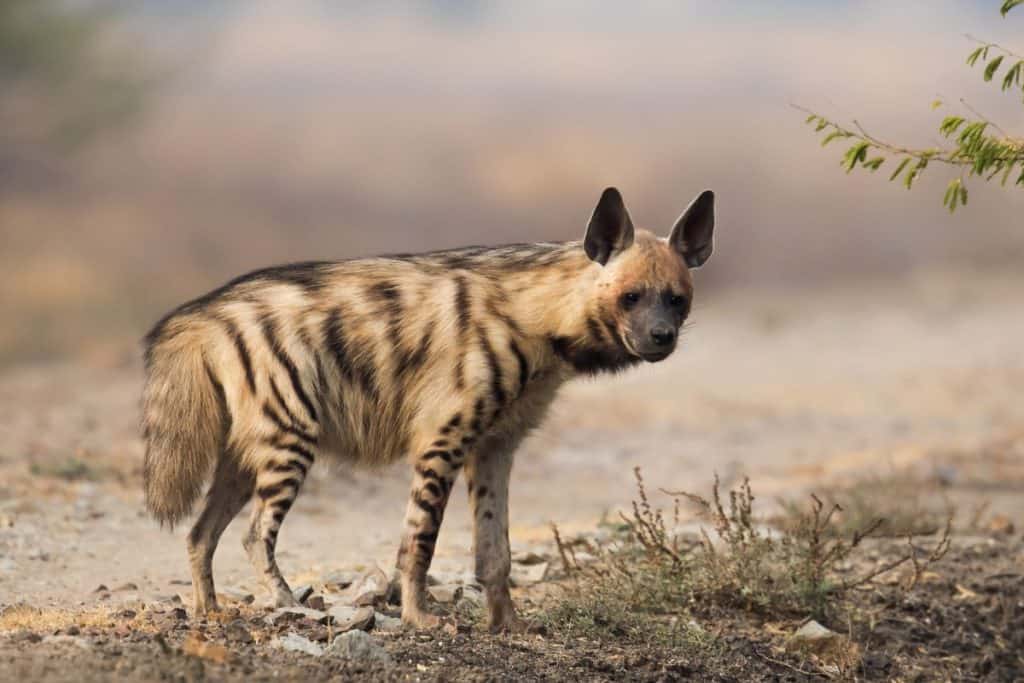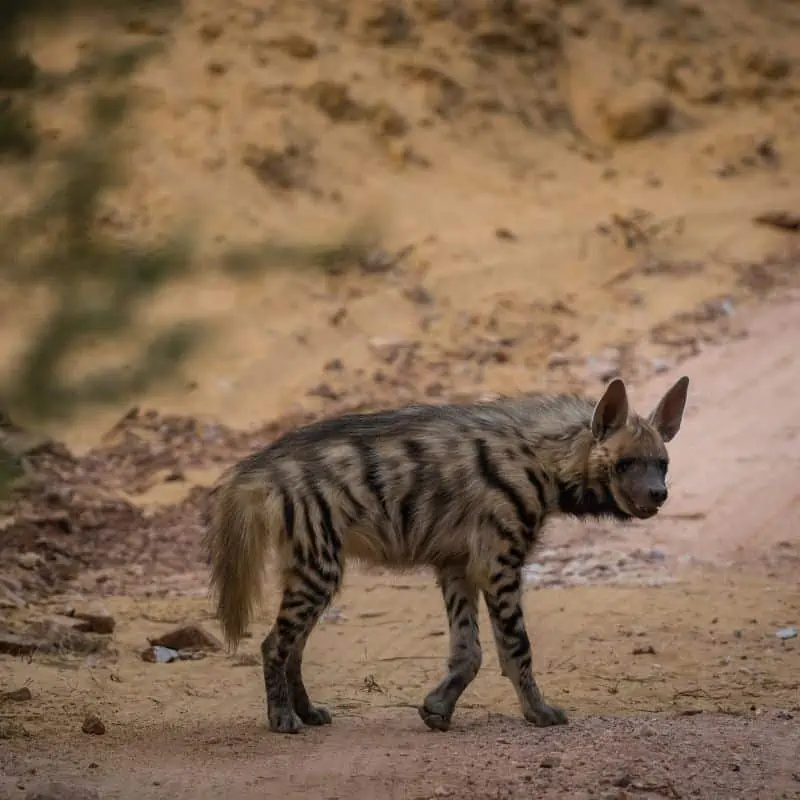The Striped Hyena is a native Hyena species of North and East Africa, the Middle East, Central Asia, the Caucasus, and the Indian subcontinent. It’s one of the least studied species of Hyenas. So, how much do we know about Striped Hyenas?
The Striped Hyena is a medium-sized African scavenger that feasts on the carcasses of large animals. With a worldwide population of 5,000 to 14,000, Striped Hyenas are a near-threatened species. They are not social animals but are incredibly intelligent, and their prominent features include longer front legs.
This article will look at the Striped Hyena in more depth; let’s get started.

Ten Facts About Striped Hyenas
If you want to know more about the famous dog-lookalike mammal, take a look at these ten interesting facts:
1. Marking the Territories With Scent
Most animals mark their territories by making different sounds, such as a bird song, or producing different scents, such as pheromones secreted by the skin glands of mammals.
Striped Hyenas, on the other hand, mark their boundaries/territories with the help of the scent gland secretions from their anal pouch.
They can also hear some sounds that human ears can’t, which helps them listen to the predators’ sounds from miles away.
2. 3-4 Month Gestation Period
The gestation period in animals is marked as when the fetus develops, begins fertilization, and the cycle ends at birth.
While most mammals have an average of 9 months of gestation, Striped Hyenas gestate in 98 to 111 days.
3. Appearance
The male and female Striped Hyenas are remarkably similar in appearance, with males having slightly bigger body types than females.
Generally, Striped Hyenas are 1 to 1.5 meters long with a tail measuring about 12.5 inches.
The face and tail of a Striped Hyena are covered in thick hair or fur. Their paws have four blunt, short, and non-retractable claws.

4. Dietary Habits
Unlike Spotted Hyenas, Striped Hyenas are scavengers and readily consume the remains of killed animals using their powerful jaws. However, some of them prey on live animals.
It has been suggested that Striped Hyenas from the three larger subspecies in Northwest Africa, India, and the Middle East kill large prey animals.
Striped Hyenas in Tajikistan and Uzbekistan have an abundance of oil-willow fruits in their diet.
They feed at landfills and can drink different qualities of water, such as soda, fresh water, and salt water.
5. Bad Reputation
The Striped Hyenas have an evil cultural reputation as child killers, witch transporters, grave robbers, and other absurd accusations.
As a result, they have been persecuted on a larger level by humans in many regions.
Some people poison Hyenas and attack them, while others get them killed by dogs. Now, Striped Hyenas are almost extinct in Bangladesh and are endangered in other parts of the world.
Unlike Spotted Hyenas, Striped Hyenas aren’t aggressive and tend to avoid conflict rather than partake in it.
Even though they’re quite timid, people tend to put all hyenas under one hood, and this means they have to share the dangerous reputation with their spotty cousins.
6. High Intelligence
An animal behavioral psychologist, Benson-Amram, created the world’s first Carnivore Intelligence Test.
It consisted of a puzzle box with a food reward inside. She believed that carnivores with high social intelligence would solve the puzzle quicker.
She checked various predators, including polar bears and lions, but Striped Hyenas solved the puzzle quickly.
According to Kevin Richardson, the famous wildlife conservationist, Duke University conducted a study showing that captive Hyenas perform better at a problem-solving test than Chimpanzees with social cooperation.
They solved all problems through non-verbal modes of communication.
7. Mating
For breeding purposes, Striped Hyenas are not so solitary and form a pair or even a polyandrous group of up to two or three adult males per single adult female.
The resulting family unit may last for years, and primarily male and female parents provide for the cubs.
On the other hand, Brown Hyenas occur in small social groups, and only males provide for the children.
The female Brown Hyenas mate with nomadic males, and males also provide care for the cubs they didn’t sire.

8. Not-so-Chirpy Behaviour
In contrast to their loud and chirpy cousins, Spotted Hyenas, the Striped Hyenas are usually mute. They only make an occasional howling or chattering sound.
A fun fact about Striped Hyenas is that they only laugh when feeling frightened or anxious.
In such circumstances, they produce a high-pitched and rapid chattering that sounds like a “laugh” but signifies alarming behavior.
9. Economic Importance for Humans
The Striped Hyenas consume unwanted human refuse and thus indirectly boost the economy for humans.
In some African villages, people also leave their garbage outside at night, so Striped Hyenas can feed on them, creating environmental stability.
They also don’t create many problems like other mammals, like attacking livestock frequently and showing aggressive behavior.
Unfortunately, Striped Hyenas sometimes allow dogs to pounce on them without attempting to defend themselves.
10. Life Cycle
After birth, the cubs (baby Hyenas) can’t see anything, and their ear tubes remain closed. They take about seven days to open their eyes.
In the zoos, experts observed that weaning (introducing to an adult diet and withdrawing the mother’s milk) of cubs takes place after almost eight weeks.
On average, Striped Hyenas live for around 12 years in the wild, which can increase to more than 20 years in captivity.
Final Thoughts On The Striped Hyena
The most underrated member of the Hyena family, the Striped Hyenas, are African scavengers who feed on large animals’ carcasses, cleaning up the landscape.
They are known for their black muzzle and pointed ears, providing excellent hearing. Unlike other Hyena species, Striped Hyenas are not chirpy.
FAQs
Can You Pet a Striped Hyena?
You can pet a tamed Striped Hyena. You can easily tame them, and you can also train them for an extended period. It is comparatively easier to pet young Striped Hyenas than mature ones. Like all wild animals, though, you shouldn’t attempt to pet a wild Striped Hyena.
Do Striped Hyenas Eat Smaller Animals?
Striped Hyenas rarely hunt, and when they do, they pursue smaller animals, such as rodents or reptiles
How Strong is a Striped Hyena?
A Striped Hyena has a jaw strong enough to easily crush parts of carcasses, including teeth, bones, horns, and hooves. The bite pressure of an adult Striped Hyena has a maximum strength of 800 pounds per square inch.
